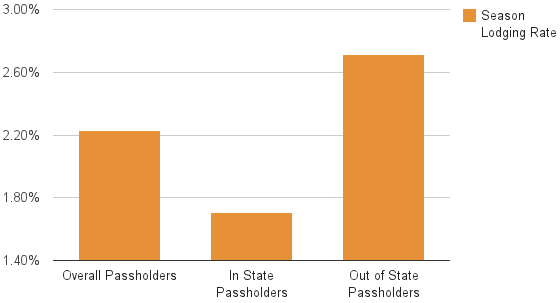
Trends
About a month ago now, we took at look at in-state/out-of-state passholder ratios for ski areas across the United States. That analysis came on the heels of an increased focus by those resorts to spread the boundaries of where a passholder might live. These expanding limits have lead to a follow-up strategy and question: how many season passholders are booking lodging at ski resorts each winter? Here’s what we found.
The Goods
To find our answer we took passholder and lodging data (excluding owners and employees) from 10 U.S. mountain resorts. In an effort to keep the analysis focused on recent results, we only used data from the last two winter seasons. First, we found an overall lodging rate (of all passholders, how many book lodging during the ski season) and then broke that down by in-state and out-of-state passholders. Here’s how it looks:

On average, about 2.2% of season passholders from our sample booked lodging during the ski season. As you might expect, in-state skiers lodged at a lower rate (1.7%) than out-of-staters (2.7%) but the difference wasn’t quite as big as we expected. What was interesting about the data we pulled was that we could see a clear uptick in lodging rate – both for in-state and out-of-state passholders – in 2012/13 vs 2011/12.
What This Means
The increase in lodging passholders in 2012/13 can be attributed to a few things: an increased focus on this group and seasonality are just two. But what it also tells us is that this metric isn’t flatlining. In other words, there are factors at play that can, and will, motivate passholders to also make a hotel reservation when they might not otherwise do so.
To us, the big takeaway from this data is the opportunity – especially with the out-of-state group – to get them to stay a night or two (more) each year as they visit the resort. While they won’t book with every offer, the data suggest that perhaps there are a good number more rooms that could be filled with a resort’s passholders each season.